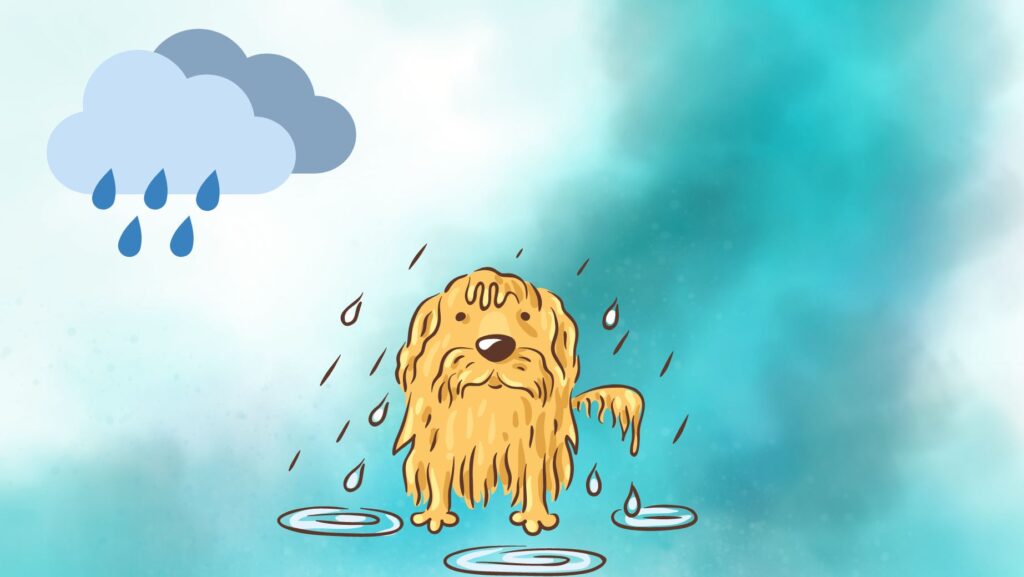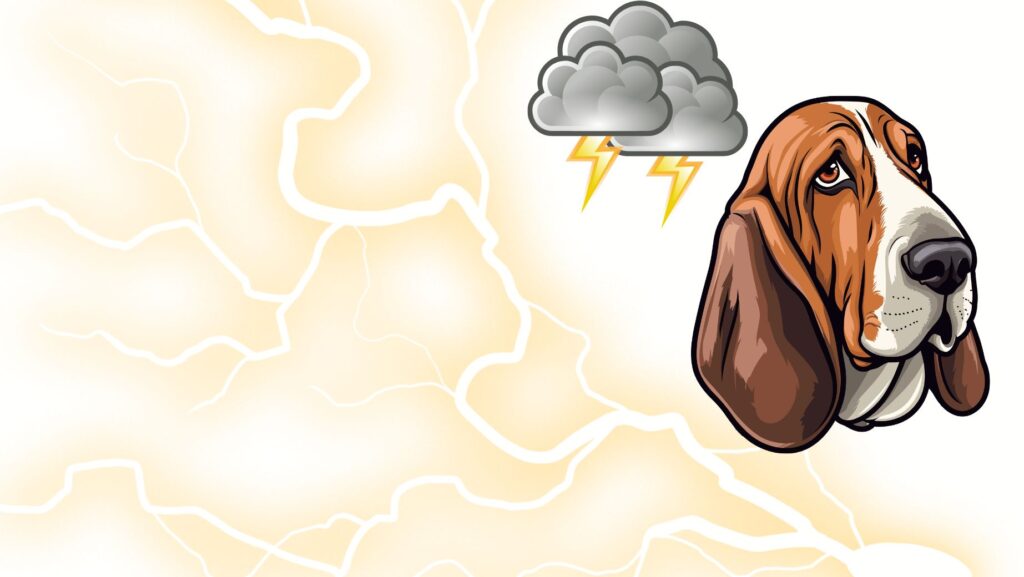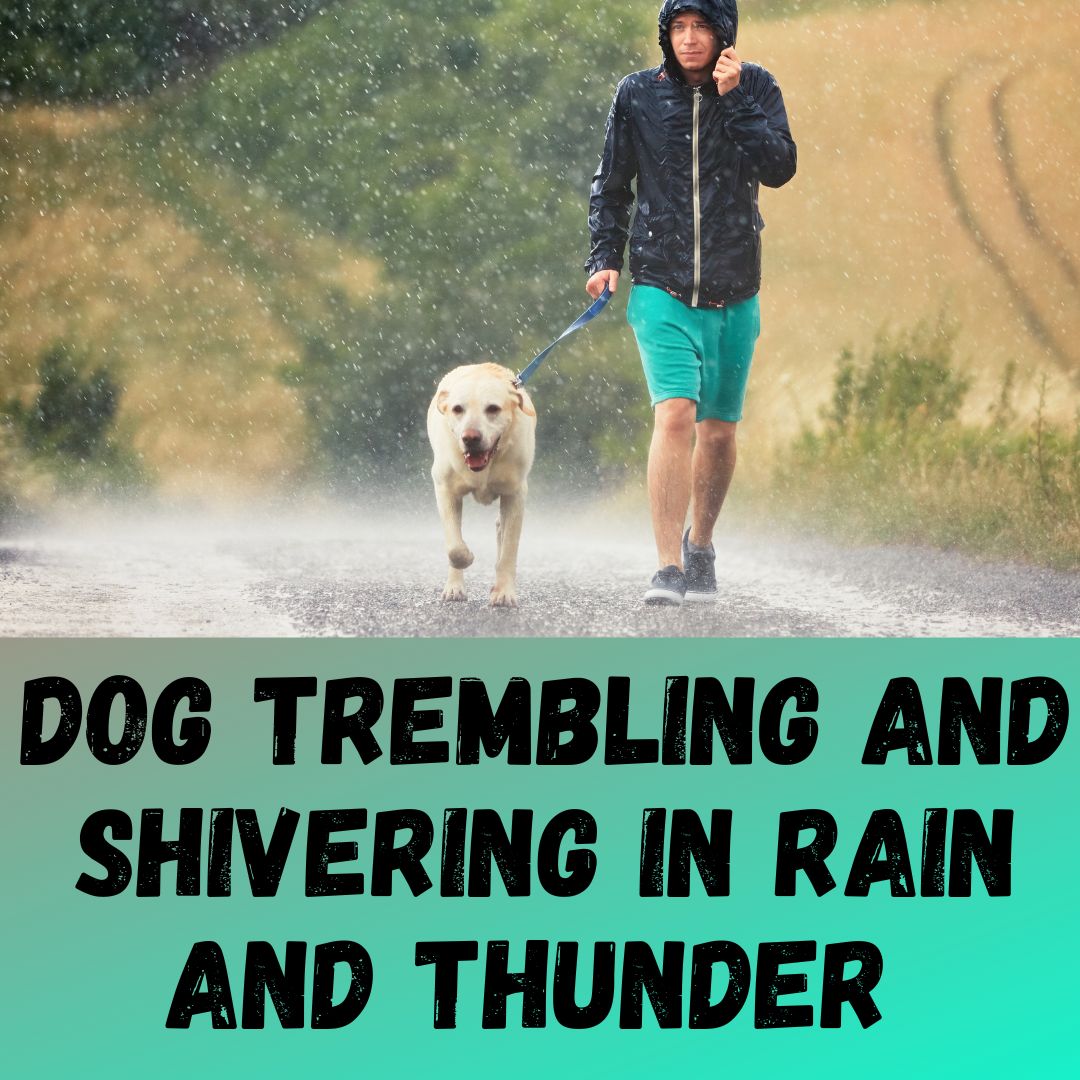Post Contents
- Thunderstorm And Rain Phobia In Dogs
- Why Do Dogs Get Weird When It Rains?
- What To Do For A Shaking, Shivering, Or Trembling Dog
- Why Are Dogs Afraid of Rain and Thunder?
- Can Rain Affect My Dog? Are Dogs Sensitive to Rain?
- How Do I Stop My Dog From Shaking in the Rain?
- how long can dogs be in the rain?
- Should I Be Worried If My Dog Is Shaking?
Thunderstorm And Rain Phobia In Dogs
Thunderstorm and rain phobia, also known as astraphobia or brontophobia, is a common fear or anxiety disorder in dogs. Many dogs exhibit signs of distress or exhibit anxious behaviors during thunderstorms or when it rains. Understanding this phobia and its impact on dogs is important for providing them with appropriate care and support. Here is more information on thunderstorm and rain phobia in dogs:
Causes and Triggers:
- Loud Noises: Thunderstorms are often accompanied by loud thunderclaps, which can startle and frighten dogs.
- Atmospheric Changes: Dogs are sensitive to changes in barometric pressure and static electricity in the air that often occur during storms.
- Lightning: The bright flashes of lightning can be visually overwhelming for some dogs, contributing to their fear or anxiety.
- Sensory Sensitivity: Dogs have keen senses, and the heightened sensory experience during storms, such as the sound of raindrops, wind, and the smell of ozone, can contribute to their phobia.
- Previous Negative Experience: Dogs may develop a fear of storms or rain if they had a traumatic experience during such weather conditions in the past.
Signs of Thunderstorm and Rain Phobia:
Dogs with thunderstorm and rain phobia may exhibit a range of behaviors indicating their fear or anxiety. These can include:
- Trembling or shaking
- Panting or drooling excessively
- Pacing or restlessness
- Seeking hiding spots or attempting to escape
- Destructive behavior
- Excessive barking or whining
- Loss of appetite
- Inappropriate elimination
- Seeking comfort from their owners

Managing Thunderstorm and Rain Phobia:
- Create a Safe Space: Designate a safe and comfortable area where your dog can seek refuge during storms. Make it cozy with blankets, toys, and items that have their scent.
- Distraction and Noise Masking: Provide distractions such as toys, puzzle games, or chew toys to redirect your dog’s focus. Playing white noise or calming music can also help mask the sound of thunder.
- Desensitization and Counter conditioning: Gradual exposure to recorded thunderstorm sounds at a low volume, paired with positive experiences like treats or playtime, can help desensitize your dog over time.
- Consult a Professional: If your dog’s phobia is severe or persists despite your efforts, consulting with a veterinarian or a certified animal behaviorist can be beneficial. They can provide tailored behavior modification techniques or recommend anti-anxiety medications, if necessary.
- Stay Calm and Provide Reassurance: Dogs often pick up on their owners’ emotions. Remaining calm and providing reassurance can help your dog feel more secure during storms.
- Avoid Punishment: Never punish or scold your dog for their fearful behavior during storms, as it can intensify their anxiety.
- Identification and Safety: Ensure your dog has proper identification, such as a collar with tags or a microchip, in case they become frightened and try to escape during a storm.
- Natural Remedies: Some natural remedies, such as herbal supplements or calming pheromone diffusers, may help reduce anxiety. Consult with a veterinarian to explore suitable options.
Remember, each dog is unique, and it’s important to tailor your approach to their specific needs. With patience, understanding, and appropriate management strategies, you can help your dog cope with their thunderstorm and rain phobia and provide them with comfort during challenging weather conditions.

Why Do Dogs Get Weird When It Rains?
Dogs may exhibit unusual behaviors or appear “weird” when it rains due to a combination of factors, including their natural instincts and sensitivities. Here are a few reasons why dogs might get “weird” when it rains:
- Sensory Changes: Dogs have heightened senses, and rain can introduce various sensory stimuli that may affect them differently. The sound of raindrops, the change in atmospheric pressure, the smell of wet surroundings, and the feeling of rain on their fur can be overwhelming or unfamiliar to some dogs.
- Noise Sensitivity: Rain can produce different sounds, including the sound of raindrops hitting surfaces, thunder, or strong winds. Some dogs are sensitive to loud or sudden noises, and the sounds associated with rain can trigger anxiety or fear responses.
- Negative Past Experiences: Dogs are capable of associating certain events or experiences with negative outcomes. If a dog has had a traumatic experience during rainy weather, such as being caught in a storm or getting frightened by thunder, they may develop a fear or anxiety response when it rains in the future.
- Changes in Routine: Rainy weather often disrupts a dog’s usual routine, such as outdoor walks or playtime. Dogs are creatures of habit, and alterations to their routine can cause confusion or restlessness.
- Barometric Pressure Changes: Some dogs are sensitive to changes in barometric pressure, which often occur before or during rainy weather. These pressure changes can cause discomfort or unease in certain individuals.
- Owner’s Behavior: Dogs are highly attuned to their owner’s emotions and behaviors. If an owner displays anxiety or concern during rainy weather, their dog may pick up on these cues and mirror the behavior, leading to a sense of “weirdness.”
What To Do For A Shaking, Shivering, Or Trembling Dog
When your dog is shaking, shivering, or trembling during a rainstorm or thunderstorm, it’s essential to provide comfort and support. Here are some steps to help your dog during these anxious moments:
- Stay Calm: Dogs can pick up on their owners’ emotions, so it’s important to remain calm and composed. Your calm demeanor will help reassure your dog and create a more relaxed environment.
- Create a Safe Space: Set up a safe and comfortable area where your dog can seek refuge during the storm. This can be a quiet room, a crate, or a designated spot with their bed and familiar items. Make sure it is away from windows and provides a sense of security.
- Use White Noise or Music: Play soothing background noise, such as white noise or classical music, to help drown out the sound of thunder. This can help distract your dog and create a more calming environment.
- Provide Physical Contact: Dogs often find comfort in physical contact with their owners. If your dog seeks closeness during the storm, gently pet and cuddle them to provide reassurance and a sense of security.
- Use Calming Techniques: Employ calming techniques that have worked for your dog in the past. This can include massage, gentle brushing, or practicing relaxation exercises like deep breathing.
- Consider Calming Products: There are various calming products available, such as anxiety wraps or pheromone diffusers, which can help alleviate stress and anxiety. Consult with your veterinarian about suitable options for your dog.
- Distraction with Toys and Treats: Engage your dog with their favorite toys or treats during the storm. This can redirect their attention and help alleviate anxiety. Puzzle toys or long-lasting chews can be particularly helpful in keeping them occupied.
- Maintain a Consistent Routine: Stick to your dog’s regular routine as much as possible during storms. Maintain their feeding, exercise, and playtime schedule to provide a sense of stability and familiarity.
- Consult a Professional: If your dog’s anxiety during storms is severe or persistent, it may be beneficial to seek guidance from a veterinarian or a certified animal behaviorist. They can provide tailored strategies or recommend anti-anxiety medications, if necessary.
- Ensure Safety: If your dog tries to seek shelter in an unsafe location, gently redirect them to the designated safe space. Ensure that doors and windows are secure to prevent escape.
Remember, every dog is unique, so it may take some trial and error to find the most effective methods for calming your dog during rain or thunderstorms. Patience, understanding, and providing a comforting environment are key to helping your dog through their anxious moments.
Why Are Dogs Afraid of Rain and Thunder?
Dogs’ fear of rain and thunder can be attributed to a combination of factors, including the loud noises, changes in atmospheric pressure, electrical charges in the air, and the sensory overload associated with storms. Some dogs may also have had negative experiences during storms in the past, further reinforcing their fear.
Home Remedies for Dogs Scared of Rain sounds:
- Create a safe and comforting indoor environment.
- Provide distractions such as toys, puzzles, or treat-dispensing toys.
- Use aromatherapy with calming scents like lavender or chamomile.
- Gradually desensitize your dog to rain or thunderstorm sounds through positive reinforcement training.
- Consult with a professional for additional homeopathic remedies or natural supplements that may help alleviate anxiety.
Ways to Calm Your Dog When the Thunder Rumbles
Thunderstorms can be distressing for many dogs due to the loud noises and atmospheric changes. Here are some ways to help calm your dog during thunderstorms:
- Create a Safe Space: Set up a safe and comfortable area where your dog can seek refuge during thunderstorms. This can be a quiet room, a crate, or a designated spot with their bed and familiar items. Make sure it is away from windows and provides a sense of security.
- Use White Noise or Music: Play soothing background noise, such as white noise or classical music, to help drown out the sound of thunder. This can help distract your dog and create a more calming environment.
- Provide a Calming Compression Wrap: Consider using a snug-fitting garment, such as a thunder shirt or anxiety wrap, which applies gentle pressure to your dog’s body. The compression can provide a sense of security and help alleviate anxiety.
- Stay Calm and Provide Reassurance: Dogs often pick up on their owner’s emotions. It’s important to remain calm and composed during thunderstorms. Offer gentle reassurance and comforting words to let your dog know they are safe.
- Distraction with Toys and Treats: Engage your dog with their favorite toys or treats during a thunderstorm. This can redirect their attention and help alleviate anxiety. Puzzle toys or long-lasting chews can be particularly helpful in keeping them occupied.
- Provide a Safe Chew: Offer your dog a safe and appropriate chew toy to help keep them distracted and provide a calming outlet for their anxiety. Chew toys can help alleviate stress and promote relaxation.
- Close Curtains or Use Thundershirts: Darkening the room by closing curtains or blinds can help minimize the visual stimulation from lightning flashes. Additionally, some dogs may find comfort in wearing a thundershirt, which applies gentle pressure and can help reduce anxiety.
- Seek Professional Advice: If your dog experiences severe anxiety during thunderstorms, consider consulting with a professional, such as a veterinarian or a certified animal behaviorist. They can provide tailored strategies or recommend anxiety-reducing medications, if necessary.
Can Rain Affect My Dog? Are Dogs Sensitive to Rain?
Rain itself does not have a direct physical impact on most dogs. However, the associated sounds, atmospheric changes, and the unfamiliar sensory experience can trigger fear and anxiety, leading to shaking or other anxious behaviors.
Dogs can be sensitive to rain due to the sensory changes it brings. The sound, smell, and feel of raindrops, along with the changes in the environment, can heighten their senses and trigger anxiety or fear responses.
How Do I Stop My Dog From Shaking in the Rain?
- Provide a Safe Environment: Create a safe and comfortable space indoors where your dog can seek refuge during rain or storms. Make it cozy, with familiar items like their bed or blankets.
- Use Calming Techniques: Use calming techniques such as gentle massage, soft music, or white noise to help distract and relax your dog during rain or storms.
- Behavior Modification: Consider desensitizing your dog to the sound of rain and storms through gradual exposure and positive reinforcement. Start with low-level rain sounds and gradually increase the volume over time while rewarding your dog for calm behavior.
- Thundershirt or Compression Wrap: Consider using a thundershirt or compression wrap on your dog during rain or storms. The gentle pressure can help reduce anxiety and shaking.
- Consult a Professional: If your dog’s fear of rain or storms is severe and impacting their quality of life, consult with a professional, such as a veterinarian or a certified animal behaviorist, for guidance and potential behavior modification techniques or medications.
how long can dogs be in the rain?
Dogs can be in the rain for short periods without any issue, especially if they have access to shelter and are not exposed to extreme weather conditions. However, the duration of time a dog can comfortably stay in the rain depends on several factors, including the individual dog’s breed, health, age, coat type, and personal tolerance to wet conditions. Here are some considerations:
- Breed and Coat Type: Some dog breeds have coats that are better suited for wet weather, such as water-repellent coats or double coats. These dogs may be more comfortable in the rain for longer periods. Conversely, dogs with short hair or less protection against moisture may become soaked more quickly and feel discomfort sooner.
- Health and Age: Dogs with underlying health issues or compromised immune systems may be more sensitive to wet conditions and may require extra care. Similarly, puppies, senior dogs, or dogs with mobility issues may be more susceptible to the cold and discomfort associated with rain. It’s important to consider their specific needs and limitations.
- Temperature and Intensity: The temperature and intensity of the rain play a significant role. In mild or warm rain, dogs may be more tolerant. However, in colder temperatures or during heavy downpours, dogs can become chilled or uncomfortable more quickly. Monitoring your dog’s behavior and body language can help determine when they may need to come indoors.
- Shelter and Drying Off: Providing your dog with access to shelter, such as a covered porch, dog house, or indoor space, is important. Dogs should have the option to seek shelter from the rain when they feel the need. Additionally, ensuring they have a dry, warm place to retreat to after being in the rain is crucial for their comfort and well-being.
Should I Be Worried If My Dog Is Shaking?
If your dog is shaking and shivering in the rain, it can be a cause for concern. Shaking and shivering in dogs can indicate various underlying issues, and it’s important to assess the situation and consider the following factors:
- Temperature: Rainy weather, especially if it’s cold, can lead to discomfort for dogs. Shivering is the body’s natural response to generate heat and maintain body temperature. If your dog’s shaking and shivering is due to cold temperatures, providing them with shelter or bringing them indoors can help alleviate their discomfort.
- Fear or Anxiety: Dogs may exhibit shaking and shivering as a response to fear or anxiety. If your dog has a phobia of rain, thunderstorms, or has had negative experiences associated with rainy weather, their shaking and shivering may be a manifestation of their anxiety. Providing a safe and comforting environment can help ease their distress.
- Pain or Discomfort: Shaking and shivering can be signs that your dog is in pain or experiencing discomfort. It’s possible that your dog has sustained an injury or has an underlying medical condition that is exacerbated by rainy weather. If the shaking and shivering persist, worsen, or are accompanied by other concerning symptoms, it is advisable to consult with a veterinarian for a thorough examination and appropriate treatment.
- Wetness and Chill: Dogs with short hair or those that are not well-suited for wet conditions may become soaked quickly, leading to discomfort and potential chilling. Ensuring your dog has access to shelter, providing them with a warm and dry space, and drying them off after being in the rain can help alleviate their shivering.
It is crucial to monitor your dog’s overall behavior and well-being in conjunction with the shaking and shivering. If you are concerned or if the symptoms persist or worsen, it is recommended to seek veterinary advice. A professional evaluation can help identify the underlying cause and provide appropriate treatment or management options for your dog’s comfort and health.

94% of pet owners say their animal pal makes them smile more than once a day. In 2007, I realized that I was made for saving Animals. My father is a Vet, and I think every pet deserves one. I started this blog, “InPetCare”, in 2019 with my father to enlighten a wider audience.
